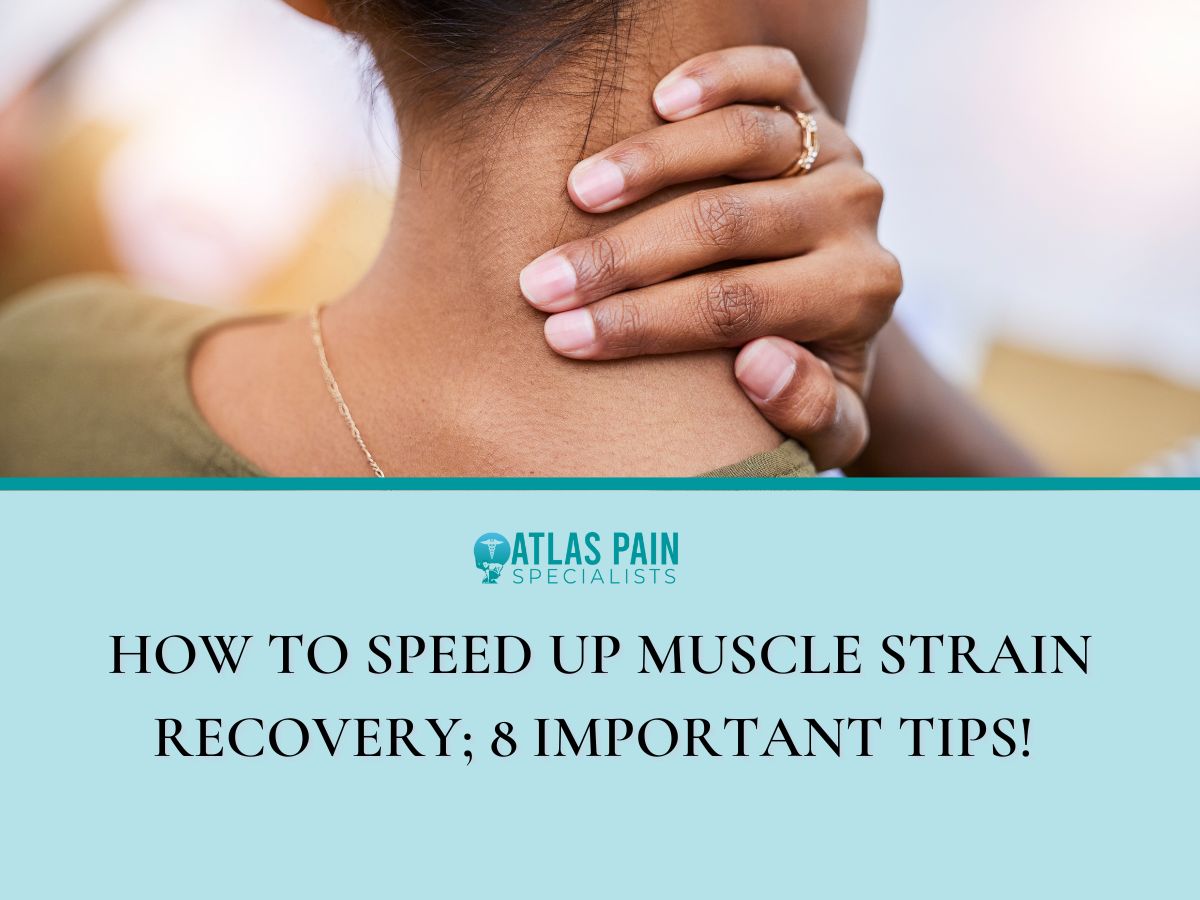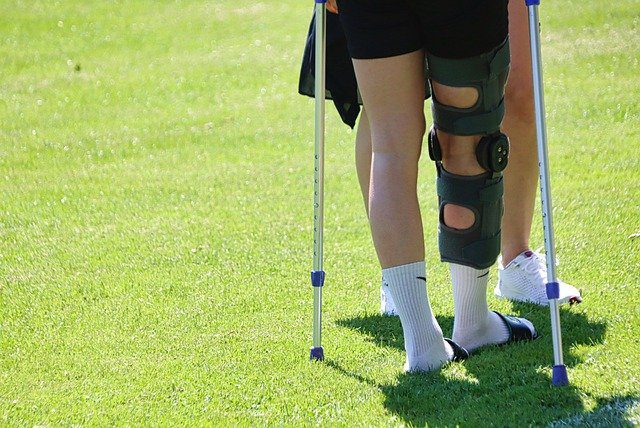

How To Speed Up Muscle Strain Recovery; 8 Important Tips!
You've once over-strained yourself and injured a muscle. Overly stretched or torn muscles result in muscle strain or pulled muscles. You can get it from working out too hard or lifting something wrongly.
Muscle strain recovery is the rehabilitation of these muscles to return them to functioning normally again. Muscle strain recovery can be accelerated in many methods, some of which are more well-established than others.
This article guides on how to speed up muscle strain recovery.
Signs of a muscle strain
Injuries of varying severity have different signs and symptoms. The hamstrings, lower back, shoulders, and neck are the most common places to suffer from muscle strains.
A common way to describe the pain is a stabbed sensation. The majority of patients fully recover when given the appropriate care.
With modest home care, you may be able to resume your typical activities in three to six weeks for a mild strain. Recovery from more severe strains might take months, and surgery and physical treatment may be required in more serious situations.
When a muscle is first injured, there is a lot of swelling and inflammation. Signs of a strained muscle include:
- Injury-related edema, bruising, or redness
- The damaged muscle is unable to perform its normal functions.
- Weakness of the affected muscle
- When using the injured muscle, a sudden ache occurs.
- Pain when the muscle is at rest
- Inflammation of a certain muscle or joint when that muscle is stimulated.
- Absence of any capacity to contract the muscle.
The importance of treating muscle strains

Muscle strains make the affected muscles may be unable to move as freely. Even if you don't need medical attention, you should seek it if your injury is severe.
Muscle strains not only cause discomfort but also make it difficult to complete your daily tasks. The first thing in your thoughts when you're feeling muscular tension is figuring out how to get it back to normal.
When a strained muscle isn't treated, the muscle gets weaker and overworks the adjacent muscles. This can lead to poor posture as a result of body changes to accommodate the pain.
Ten tips on how to speed up muscle strain recovery
Overstretching and partial or total rips of the muscle are major causes of muscle strain. Working with pain management specialists is the best way to address your injuries if you're suffering from severe or chronic muscle pain.
Meanwhile, there are a few things you can do to speed up your recovery from an injury and keep the injured muscle from suffering further harm.
These ten muscle injury recovery methods will help you get better faster.
1. Elevate the injured muscles
To speed up muscle healing, elevate the muscle to increase blood flow and distribute weight evenly. This enhances blood flow to the areas.
Elevating a swollen muscle might be painful, and zero-gravity massage chairs can help with strained leg muscles. Raise the damaged muscle above the heart to prevent fluid accumulation.
The zero-gravity position raises your legs above your heart. This position speeds up recovery from muscle strain.
Immediate therapy and effective techniques are needed in order for strained muscles to heal. Minor muscular strains can be treated at home, but significant injuries require medical attention.
2. P.R.I.C.E.
P.R.I.C.E. (Rest, Ice, Compression, and Elevation). Remember this acronym for muscle injuries.
Anti-inflammatory drugs are popular because inflammation is viewed as a harmful process, although it aids with healing. This stage of healing allows the body to shed old, harmful tissue and create new, healthier tissue.
This phase becomes problematic when the body isn't exposed to a healing environment. PRICE is used as inflammation progresses and muscle injuries recover through inflammation, proliferation, and remodeling.
The inflammatory phase lasts 3-7 days, and P.R.I.C.E. ensures that the body has time to heal before engaging in potentially provocative activities, no matter how modest.
Instead of lounging all week, take a couple of days off to avoid worsening inflammation. Ice reduces swelling and pain during an injury's inflammatory phase, speeding recovery.
A tensor bandage can also reduce swelling and increase nutrient-rich blood flow to an injured area. After a strain, massage your muscles three times a day for the first few days.
Elevation reduces swelling and if you have a lower leg injury, lay on your back with your foot on a cushion. When used together, these tips help speed up muscle damage recovery.
Applying ice or a cold compress to a strained muscle speeds up recuperation. Ice for about 10 minutes, but don't put the ice directly on your skin.
Wrap a tight muscle with a towel before applying ice or cold compress. Ice burns don't help muscle recovery as ice crystals develop in the cells and stop blood flow when applied directly to the skin.
Compression seems to function best during activity and helps reduce swelling and inflammation, which slows healing. Whenever possible, compress the damaged muscle by using compression clothes or an A.C.E. bandage. But don't wrap the muscle too tightly, or you'll cut off blood flow.
3. Physiotherapy assessment and treatment
A physiotherapist can diagnose your condition, teach you how to manage it, and recommend the best treatment. Local physiotherapists can help you determine the optimal recovery plan.
Guidance and encouragement can speed up people's healing, and your doctor may advise extra therapies to help you recover faster and return to your hobbies.
Physiotherapists treat muscular injuries using many methods, including:
- Soft tissue release
- Joint mobilizations
- Electrotherapeutic modalities
- Transcutaneous nerve stimulation (TENS)
- Neuromuscular electrical stimulation (N.M.E.S.)
- Interferential Current Therapy (IFC)
- Electroacupuncture
3. Do Low-Impact exercise and stretching
Low-impact exercises and stretching help recover muscles while resting, and mobility speeds muscle recovery. Both strategies help expedite muscle recovery by ensuring blood flows freely through the injured area, delivering oxygen and nutrients to damaged tissue.
Leg swings relax muscles and reduce injury risk. This keeps your joints and muscles mobile while recuperating.
Stretching helps with flexibility, discomfort, and stiffness. If you can't get out of bed or want to rest and stretch, a massage chair can help.
You shouldn't exacerbate your injury while recuperating. Overstretching causes muscle injuries, which are common in runners, yogis, and weightlifters.
While recuperating, choose a workout that won't stress your injured muscle. Swimming can alleviate an ankle or calf problem and prevent it from worsening.
4. Stay Hydrated
Hydration is key to injury or strain recovery. Water flushes toxins from the body, nourishes cells, relieves muscle stiffness and stress, and maintains pH equilibrium.
Drinking plenty of water keeps our bodies healthy, and after an injury, you should take adequate water as dehydrated muscles heal more slowly. Drink 16 to 24 ounces of water per pound you lose while exercising. If you dislike the taste of water, organic mint water or flavored water will also do the trick.
5. Heat Therapy
First, R.I.C.E. therapy should be done for a pulled muscle (rest, ice, compression, and elevation). Heat should be avoided for 72 hours to prevent puffy, inflamed skin.
After 72 hours, adding heat to a therapy regimen can improve blood flow and circulation. After icing, utilize heat to speed muscle healing as heat therapy reduces edema and inflammation while keeping muscles supple.
Heat therapy dilates arteries and boosts blood flow (which should actually be warm, not hot), resulting in relaxed stiff muscles. Better circulation provides more oxygen, nutrients, and lactic acid for muscle regeneration.
For the best results, use a massage chair with heat functions. A heated massage chair features speeds up muscle mending and provides a full-body experience.
6. Increase or Improve sleep

Your body can self-heal in many ways if given the right conditions. Adequate rest is crucial to accident recovery (and the "R" in the "RICE" treatment method).
Most people require 7-9 hours of sleep, but extra sleep may be required for those with active lifestyles. Whether you have a muscle strain, a torn tendon, or a broken bone, you need rest.
When on your back, place a pillow between your knees to reduce back, hip, or knee pain. Invest in supportive pillows and try not to sleep on your uncomfortable side.
Laying on your stomach with a pillow beneath your abdomen is another option.
7. Lifestyle changes
Lifestyle considerations cover many topics, including diet, sleep, interests, and drug usage. Even if lifestyle variables are hard to change, you can enhance your health.
Smoking and excessive alcohol usage can worsen inflammation and slow healing. Many patients feel smoking or drinking might relieve their symptoms, but this just prolongs healing and increases their risk of addiction.
Tobacco and alcohol are unhealthy, and you should limit both when healing from a muscle injury. Alcohol lowers protein synthesis and glycogen replacement, and tobacco can damage the musculoskeletal system, but there's no link to injury rehab.
You shouldn't risk muscular damage while recovering from an injury. Reducing the frequency or amount of these substances can help injury rehabilitation.
Adequate sleep helps injured patients recover. Even if you sleep in a less-than-ideal position for your injury, maximizing your sleep will help you heal (keep in mind specific orders from your doctor or physiotherapist may override this general concept).
8. Foods for recovery

Proper nutrition and hydration are important for health and fitness, but there's no specific diet for muscle injury healing. However, sugary and processed foods should be avoided as sugar, a simple carbohydrate, might hinder the body's ability to heal.
The evidence on processed foods is less clear. These are a few foods you should consider taking to speed up muscle recovery.
- Protein-rich foods
Protein is important for numerous human components, including the muscles. Protein-rich diets may help you recover faster when you return to exercising.
You should boost your protein intake when healing from a muscle injury, and taking whey or collagen supplements can boost your protein intake without changing your diet. Even if you're not exercising much, keep eating protein as protein inefficiencies during recovery can impair muscle mending and cause inflammation.
A sports injury often requires immobilization which may affect muscle mass and strength. Taking protein can minimize this loss.
Protein-rich diets may reduce inflammation, which can slow recovery. Increasing your protein intake when training the newly repaired body part promotes muscle regrowth.
Because of these reasons, you should regularly eat high-protein meals. How you distribute these items throughout the day also matters.
Pre-bedtime protein may help your body create muscle while you sleep. After an injury, eat protein-rich meals and snacks to decrease muscle loss and promote recuperation.
- Fiber-rich foods
Healing often requires immobilization or restricted use of an injured body component which affects muscle mass and strength. To manage your weight throughout rehabilitation, you may wish to eat differently than before your injury.
Vitamin C, magnesium, and zinc, all crucial for recovery, are abundant in high-fiber diets.
- Fruits and vegetables
Vitamin C can be found in fruits and vegetables. Vitamin C helps your bones, muscles, skin, and tendons by producing collagen, a coenzyme needed for tissue repair and regeneration.
Vitamin C heals wounds and helps the body heal after an injury. Vitamin C, an antioxidant and anti-inflammatory, may help you recuperate by reducing excessive inflammation.
It is easily accessible and can be found in citrus fruits, bell peppers, dark leafy greens, kiwi, broccoli, berries, tomatoes, and papaya. Vitamin C supplements have a mixed record for boosting athletic performance or accelerating recuperation.
Summary
Sedentary lifestyles require less energy, and taking high-fiber diets can reduce calorie intake without increasing hunger.
- High-fiber diets can help injured people heal faster and lose weight.
- Protein-rich foods may help you eat less without feeling hungry.
- Fruits, vegetables, and legumes high in fiber help you feel full after a meal.
If you planned to lose weight before the injury, you might want to reconsider your decision. Cutting calories too much might impede wound healing and induce muscle loss, which can hinder recovery.
Maintaining your weight while healing is very crucial.
Frequently asked questions
How can I speed up muscle strain recovery in my legs?
Although a muscle strain can occur in any muscle, hamstring and calf strains are the most prevalent.
Knee and calf massages are helpful for muscle strain in strained legs. They can aid in loosening up and stretching the muscles in the leg.
Is a sprain the same as a strain?
A sprain involves damage to the bands of tissue that link two bones, while a strain involves damage to the muscles or the band of tissue that connects a muscle to a bone.
Strains are a type of muscle or tendon injury that can be quite painful (tissues that attach muscles to bones). Ligament injuries are known as sprains (tissue that connects bones or cartilages or holds a joint together).
About Dr. Sean Ormond



